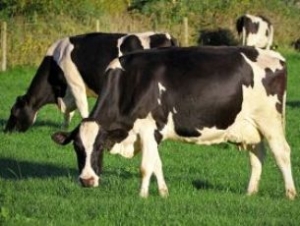Dairy farming

Dairy farmers around the world are well used to feeding their cows with lucerne and now farmers in the UK are starting to pay attention to the advantages of the crop.
Farmers can also include lucerne instead of grass silage in their cow’s diet without impacting on animal performance, according to the findings of the latest AHDB Dairy funded research.As a crop, lucerne is drought tolerant; can be harvested multiple times, which helps spread the work load; and does not require nitrogen, saving on inputs.
The work, which was carried out at Harper Adams University (HAU) and the Scottish Rural University College (SRUC), examined what would
happen when lucerne silage replaces grass silage in the diet of dairy cows.
The cows received various portions of grass silage, lucerne silage and maize silage as outlined in Table 1 below, with diets formulated to contain the similar levels of energy (12 MJ ME/ kg DM) and protein (176g CP/ kg DM).
|
|
HAU Study |
SRUC Study |
||||||
|
|
Control |
LS1 |
LS2 |
LS3 |
Control |
LS1 |
LS2 |
LS3 |
|
Ingredients (g/kg DM) |
|
|
|
|
|
|
|
|
|
Grass sileage |
222 |
111 |
0 |
0 |
574 |
431 |
287 |
144 |
|
Lucerne silage |
0 |
111 |
222 |
333 |
0 |
144 |
287 |
431 |
|
Maize sileage |
331 |
332 |
332 |
222 |
0 |
0 |
0 |
0 |
|
Energy concentrate |
297 |
303 |
308 |
316 |
363 |
373 |
392 |
415 |
|
Protein concentrate |
142 |
138 |
129 |
119 |
67 |
43 |
22 |
0 |
|
|
|
|
|
|
|
|
|
|
|
Animal performance |
|
|
|
|
|
|
|
|
|
Intake (kg DM/day) |
24.5 |
24.9 |
24.5 |
23.4 |
19.8 |
21.2 |
23.4 |
24.6 |
|
Milk yield (kg/ day) |
42.2 |
40.7 |
40.2 |
40.5 |
32.0 |
32.0 |
32.7 |
33.2 |
|
|
|
|
|
|
|
|
|
|
|
Feed costs |
|
|
|
|
|
|
|
|
|
£/kg milk |
0.11 |
0.12 |
0.12 |
0.11 |
0.11 |
0.12 |
0.14 |
0.15 |
|
£/kg fat and protein |
1.53 |
1.67 |
1.69 |
1.51 |
1.57 |
1.71 |
2.00 |
2.14 |
So how did the animals perform on these diets? In Table 1 above, readers can see that at HAU, lucerne replaced grass silage in LS1, LS2 and LS3. However, in LS3 maize silage was also reduced a portion of the maize silage. This in turn reduced intake in those cows by 1.2 kg DM/ day.
At SRUC, lucerne replaced grass silage only and in this case, intake was increased with higher inclusion rates of lucerne.
Yet, despite the differences in intake, lucerne inclusion did not affect milk production.
The similarities in milk production would be partly expected at HAU given how close the diets were in energy and protein content and the small difference in intake.
However, at SRUC the failure of milk yield to respond to higher intake reduced milk production efficiency and increased the feed costs/ kg milk.
This may be due to the lower digestibility of the lucerne based diets at SRUC which means that as intake went up, the amount of energy and protein available to the cow to produce may have been similar.
For both studies, the results were highly dependent on the quality of the lucerne itself and the quality of the forage it replaced. Where lucerne is included, farmers should carefully reformulate the ration to account for the higher protein content of the forage.
Farmers who are considering growing lucerne next year can find out more information on the establishment of the crop by looking at AHDB’s Growing and Feeding Lucerne.






















